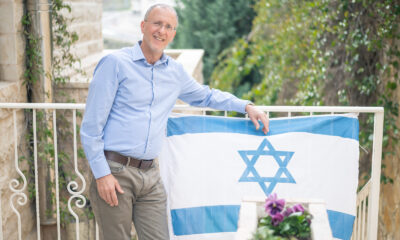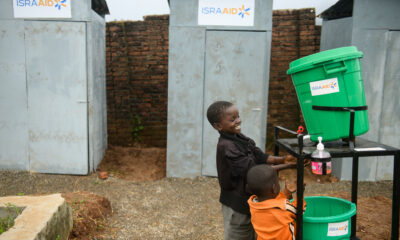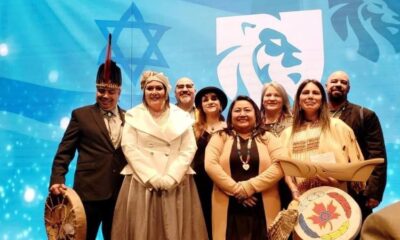
Israel

There from the start: Israel’s pioneers and fighters
It’s hard to imagine a world without a Jewish state, but for most of Jewish history, this was the reality. Yet a small number of our nation was in British Mandate Palestine when the state of Israel was proclaimed on 14 May 1948. It was an unforgettable moment in their lives, and many then risked their lives to defend Israel in its earliest hours.
Being there was the culmination for many of a long struggle to survive the Holocaust. Henia Bryer (née Fishman) arrived before the state was created, having been through the horrors of the Radom ghetto and the concentration camps of Plaszów, Majdanek, Auschwitz, and Bergen-Belsen. She also survived a death march.
So, the day she heard that she was now living in a Jewish state was “when I finally felt free and safe”, she says. She was in her early 20s, and full of hope for the future in spite of everything she had suffered. “The British left, and we stayed up all night listening to the wireless. It was a night to remember! We danced in the streets, and every bar was open.” She and so many other Jews went from a state of uncertainty and exile to the knowledge that they finally had a small corner of the earth to call home.
But the next day, reality dawned, as the Jewish state had to defend itself from invading Arab armies intent on destroying it. Bryer was already part of the Haganah, and still has her call-up card and photographs of her in her uniform. “We would receive uniforms from different countries. I was in the army for two years, and did all sorts of things – from helping in the canteen to helping find aeroplanes, which we really needed.”
On Israel’s first Independence Day, she marched proudly with the other Haganah women. Now, as Israel celebrates 75 years, she says those early days were “very hopeful”, and she always believed the Jewish state would endure. She would have loved to have stayed in Israel, but eventually settled in South Africa, where she lives today.
Esther Mayo (née Gabay) was born on Rhodes Island on 20 December 1932, but she and her family miraculously escaped the Nazis, spending a number of years in Tangier, Morocco. Her father always wanted to go to the land of Israel, and eventually, they were given the opportunity to settle in Canada or British Mandate Palestine. He chose the latter. The day they walked off the boat at the port in Haifa in 1945, people told them the war in Europe had ended.

The family lived in Jerusalem and Tel Aviv. “On the day of independence, we all sat with our ears up close to the wireless, listening to which nations would recognise the Jewish state. When it was announced, we were all crying. We had many Rhodes neighbours who survived the war and lived close by. We all gathered and cried together.” Mayo eventually met her husband, and they settled in what was Southern Rhodesia. Later, she came to South Africa, and then returned to Zimbabwe, where she still lives today.
It’s a little-known fact that the first group of South African volunteers who came to support the fledgling Jewish state were smuggled ashore from the ocean.
“Volunteers first attempted to reach British Mandate Palestine on 15 December 1946,” says Joe Woolf, who wrote about this history. Eight young men, all members of various Zionist youth movements, travelled through Africa in a second-hand military three-ton Dodge truck. They got as far as a town called El-Deum in the Sudan. Shortly after leaving El-Deum, two of them were knocked off the truck. One suffered a cracked vertebra and was sent to hospital in Khartoum. The truck had to be sold to pay for the seriously injured volunteer to be flown back to South Africa.”
According to Woolf, six of the eight returned to South Africa from Port Sudan, experiencing all sorts of adventures along the way. The seventh was the only one to reach Palestine in 1947, via Alexandria, almost a year after the failed attempt. The others eventually reached Israel in Machal (foreign volunteer) groups, and served in various army units in 1948.
The second attempt was made by sea in May 1947. Three Cape Town Jewish businessmen, hoping to establish a Jewish fishing fleet in the Mediterranean, acquired a 500-ton whaler which had been a Union Defence Forces minesweeper. It was renamed Drom Afrika I. Seven young Jewish men, members of various youth movements, were part of the all-South African lower deck.
The voyage via the Suez Canal lasted two months, and it was the first ship to sail into Haifa flying the flag of the future Jewish state, infuriating the British authorities who didn’t permit the crew to land. The ship and its crew spent several frustrating months in the eastern Mediterranean, much of the time in dry dock in Alexandria.
Shortly after the approval of the resolution of the United Nations General Assembly on 29 November 1947, these Jewish sailors were smuggled ashore by the Haganah.
Several South African Jewish pilots as well as one non-Jewish pilot flew a number of small civilian aircraft from South Africa to Israel, arriving on the second day of the new state. South African Machal served in all branches of the Israel Defense Forces, and included about 170 front-line kibbutz members, a total of about 870 volunteers. This is why Henry Katzew’s book on South African Machal is called South Africa’s 800.
Seven South Africans died in battle: Yehezkiel “Chatzi” Berelowitz; Zvi Lipschitz; Gideon Rosenberg; Meir “Matey” Silber; Eddie Cohen; Leslie Bloch; and Lou Hack.
About 100 women were among the 800 who came to defend Israel. One qualified nurse, determined to serve, left behind her one-year-old and five-year-old children with her mother and husband. A South African nurse delivered the first Jewish baby boy born in Beersheba after 2 000 years.
Some South Africans held important command positions. Former World War II veteran and fighter bomber crewman Harold “Smoky” Simon was chief of Israel Air Force (IAF) operations at the beginning of the IAF’s creation. The role of one IAF fighter squadron commander, Syd Cohen, was so important, he was honoured by a send-off of four Spitfires as he left Israel after his service to continue his medical studies in South Africa.
Many South African Machal volunteers interrupted their university studies, and at least seven interrupted their medical studies twice: first to serve in World War II and then again in 1948. When they qualified, they were about 10 years older than their classmates.










